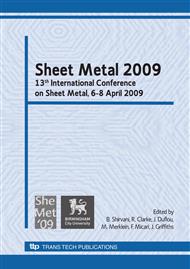p.61
p.69
p.79
p.87
p.97
p.105
p.117
p.127
p.143
Aluminum Alloy Tube Welding by Means of High Power Diode Laser
Abstract:
A process innovation is proposed by the authors to weld aluminum alloy tubes by means of a high power diode laser. In order to make the temperature profile uniform along the entire welding line, multiple passes of the laser source along the welding path can be performed at very high scan speeds. In the current study, this effect is achieved by focusing the standstill laser spot on the external surface of the aluminum alloy tubes which were put in rotation at high speed. The tubes were clamped together by using a threaded rod passing inside the tubes. Experimental tests were performed by changing the aluminum alloy heat treatment (6060 T1 and 6060 T5), the length of the samples to weld (80 and 100 mm), and the laser power (ranging from 800 to 950 W). The outer diameter of the tube was 10 mm, the thickness was 1 mm, and the rotational speed was kept constant at 1000 rpm. The welding time was monitored during the tests and ranged from 30 to 100 s in dependence on the material and process parameters. Specimens were extracted from the joints to perform tensile tests so as to measure the tensile strength. In the best condition, a high tensile strength was obtained (about 140 MPa).
Info:
Periodical:
Pages:
97-104
Citation:
Online since:
March 2009
Price:
Сopyright:
© 2009 Trans Tech Publications Ltd. All Rights Reserved
Share:
Citation:


